Sometimes nature can surprise us. My venture to rid our place of Cane Toads
gave us the proverbial ‘gift that keeps on giving’. And in more
ways than one.
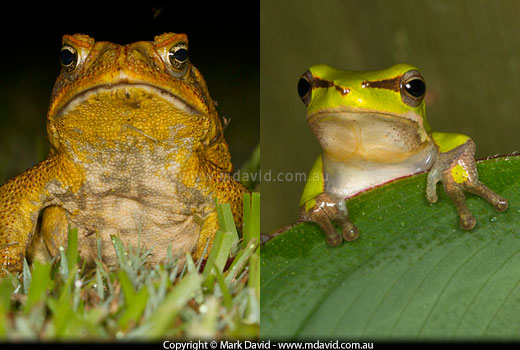
Before and after: Cane Toad (left) and Eastern Dwarf Tree Frog (right)
Cane Toad city
When my girlfriend and I moved to a one-acre block in country Queensland we expected
to see a few Cane Toads. I laugh at that now. It was like expecting to see a little bit
of ice at the South Pole.
It took a wet summer night to drive the point home. I went outside with a torch
and they were everywhere. I was stunned to see so many because in the daytime, apart
from the occasional squashed specimen on the roads, you’d never know they existed.
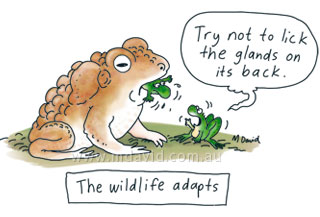
Now, in case you hadn’t heard, the Cane Toad is a large, invasive pest species
introduced into Australia. Wherever it goes, it kills indigenous species either by
eating them, or by poisoning when a potential predator tries to eat it, thanks to two
large glands full of poison on their backs. Even their tadpoles and eggs are poisonous.
Thankfully I also found some tree frogs — cute, bright green critters two or three
centimetres long, which would sometimes climb right up the glass outside our windows,
although there weren’t nearly as many of those. The Cane Toads outnumbered them
at least three to one.
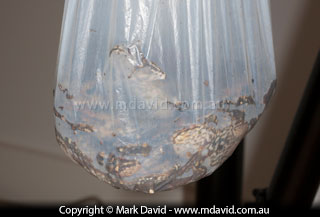
A garbage bag laden with Cane Toads after five minutes outside
with a torch.
So that was the night I started catching Cane Toads.
I don’t know how many I caught that summer because I stopped counting after
about a week (when I’d passed a hundred). In fact during one ten-minute session
I caught thirty. When I told some of the locals about this they were surprised. They
didn’t think there were that many Cane Toads in the area. But then maybe they
didn’t get out at night when the Cane Toads were visible. I had learned that if
you don’t get outside with a torch and see for yourself you’ll never know
how bad things are.
Cane Toad drought
The next summer I was expecting to go through the whole business again. Once again
my expectations were wrong. Despite going outside with my torch during all the best warm,
wet nights, I only found about ten Cane Toads in the whole season. They were usually big
ones at the edges of our block, and I’m guessing they had been hopping in from
somewhere else.
So I didn’t see a return of the previous ridiculous numbers, which was good
news. But I had another surprise waiting.

Some of the foliage outside our house showing a fairly typical
sighting of tree frogs. There are four frogs (two species) in this photo.
Something unexpected
After the Cane Toads were gone the numbers of tree frogs exploded. Even though the
Cane Toads aren’t able to climb up the plants to reach the tree frogs, those tree frogs
often fall out of the foliage too. And to get to the foliage in the first place, the tree
frogs have to make a long journey hopping up past the toads from a nearby dam. Cane
Toads are opportunistic feeders with an appetite for almost anything. A tiny tree frog
landing in front of it would make a tempting snack. Now that the Cane Toads were gone
the tree frogs were reaching the foliage unhindered. Where there used to be about three
times as many Cane Toads as tree frogs, now the tree frogs outnumbered the toads about
twenty to one!
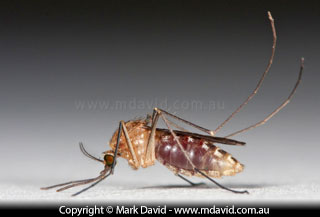
One of the first photos I took after moving into the area: A
mosquito with a full belly
Perhaps the best bit
Okay, here’s something I really didn’t expect, although it made
sense too when I started to think about it. The mosquitoes were gone.
During our first year living at the new place we were being constantly harassed by
mozzies. We put that down to being one of the features of living in the semi-tropics
and went through a lot of insect repellant and always slept with a fan running
(mozzies find it harder to get to you if the air is always moving). But now it was
rare to even find a single mosquito.
Since the tree frogs began appearing in such large numbers I’ve had plenty
of chances to watch them. On some occasions I’ve seen one eat up to half a
dozen small insects in a minute. They are unbelievably determined and persistent stalkers
and predators of small insects, often forgetting all about me if there was a potential
meal nearby. So getting back to the mosquitoes, during the daytime they don’t keep
flying around. Instead, they chill out some place in the foliage around the house where
the Cane Toads were never able to reach them. But which was now crawling with hungry
tree frogs.
You just know good’s going to triumph over evil here, don’t you.
So what’s stopping new mosquitoes from flying in every night? Well, it turns
out that mosquitoes are rather weak fliers, unlikely to cover much more area than about
an acre, which just happened to be the size of our country block. So if you rid that
much space around your home of mosquitoes then you shouldn’t get too many more
of them. Sure, new ones can be blown in on the wind but now their first stop would
be to settle down into foliage that was teeming with hungry tree frogs.
What’s not to love about that?
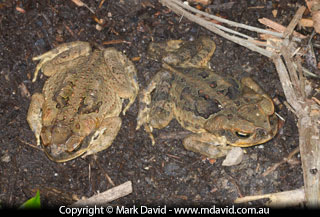
During the daytime Cane Toads will remain hidden, but at night
they prefer to come out into the open. These two toads found a clear patch in a garden
bed.
Ridding your garden of Cane Toads
Catching the toads and killing them
(humanely of course)
can be more effective in ridding your garden of these pests than many people realise.
I catch them by picking them up by their back legs and lowering them head-first into
a plastic bag. Be aware that the toads can release a nasty poison from sacs on their
backs, which can squirt out towards you if you treat them roughly. Getting that
stuff in your eyes is a serious matter and so a lot of experts recommend wearing
goggles. For the same reason, they urge that you wear gloves and/or wash your hands
thoroughly after you’ve been in contact with them.
Don’t bother looking for mature Cane Toads in the daytime because they’ll
be too hard to find, perhaps hidden under logs and rocks, inside pipes or drains or
even crouched low in thick foliage. I’ve even seen them huddled down in the lawn
if the grass is high enough. I found the best time to look for them is about an hour
after dark in the warmer months and especially just after rain, when they hop out into
the open. What I’m talking about here are regular patrols with a plastic bag and
a torch. A few minutes outside at night after rain is all it takes.
Different areas will get different results
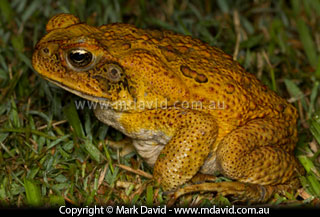
I found most of the toads on the lawn, which made them easy
to see and easy to catch.
In places at the invasion front — I’m talking about those parts of
Australia which the Cane Toads have only just reached — the practice of ridding
them from your back yard simply by catching them might not be effective. We can thank
Sydney University’s Professor Rick Shine and his colleagues for some insights
into what’s happening there. It turns out that the first pioneer toads to reach
the furthest parts of their range are the results of generations of breeding among the
fastest toads. We know they’re the fastest because they were the first ones to reach
the new areas. So then, those toad super-athletes bred with the other super-athletes
that were travelling with them, and that resulted in them producing even faster
toad offspring. Generation after generation of that kind of selective breeding
produced toads which seemed to only want to keep moving, and moving quickly. So, in the
places where the toads have only just arrived, they charge through in waves. That
means if you go around at night picking up the Cane Toads in the middle of their invasion
front, then chances are a bunch of new ones will soon be racing through your block to replace them.
By contrast, the ones way back at the heart of their range where they’ve
existed for a long time, are more likely to be the descendants of multiple generations
of the more sedentary individuals. In this instance we’re talking about
toads that have passed on their genes after distinguishing themselves
by not moving on at all. And so I was lucky enough to be living in an area with those
sedentary populations of toads. Specimens from that kind of population are much less
likely to be instantly replaced by a individuals travelling through from
neighbouring properties.
So once you get your place (mostly) toad-free, how do you keep it that way?
Remove the eggs
If a single Cane Toad can produce tens of thousands of eggs in a single clutch,
then you can see how quickly one breeding pair can lead to a massive repopulation of
toads. That means that if you have a pond, there is an equally big advantage in simply
removing the Cane Toad eggs from it.
Thankfully, Cane Toad eggs are quite distinctive. Unlike regular frogs’ eggs
that form into masses of dotty jelly, Cane Toad eggs are laid in long dotty strings.
Simply pull the strings out of the water and allow them to dry.
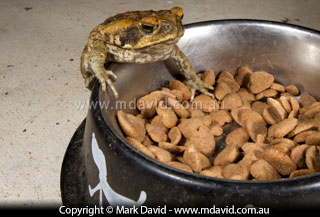
Don’t tempt them: A Cane Toad climbs into a bowl of
uneaten dog food.
Don’t be such a generous host
Some people give their Cane Toads a hearty meal every night. I’m not saying
they intend to — I’m talking about the practice of leaving uneaten dog
food sitting outside in bowls after dark. It’s not just dogs that grow big and
hairy-chested on a diet of dog food. Cane Toads love the stuff. So switch to feeding
your pets indoors. Likewise, don’t reward the toads with a bowl of water
outside at night either.
Elevation
Unlike tree frogs, Cane Toads can’t climb vertical surfaces. So if you want
to have a frog pond in your garden, make it the above-ground type. If you can’t
do that then put your pond in an area enclosed by a small smooth-surfaced fence about
50cm high. The toads don’t like grasses around the edge of their breeding
pond either.
Fence them off
Some people are now surrounding their entire properties with fencing, dug into the
ground and extending knee-high, and made of stuff like bird wire or shade cloth. This
is created as a way of keeping the Cane Toads out. Be aware that during a tropical
downpour when rainfall can sometimes be measured not in millimetres but inches per hour,
(our property once recorded eight inches of rain in one hour) such an approach might
have implications for drainage, especially if it can become clogged with leaves.
Lighting
Cane Toads love feeding on the insects that are attracted to lights, so minimise
the use of night-lights around the garden.
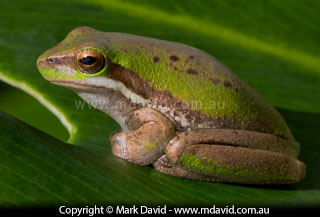
One of the many Eastern Dwarf Tree Frogs around our home. It’s
not by accident that so many of my photos are of tree frogs now!
Water
Cane Toads like to be wet every couple of days, so reducing the use of sprinklers
will also make them feel less at home.
Well worth it
It might seem like a lot of work but in my case it wasn’t. And any time I want
I can see cute tree frogs, and can take photos of them without being constantly
bitten by mosquitoes. Our tree frog numbers are the envy of our friends. You might be
very surprised what a difference you can make in your own back yard.


Birds
















